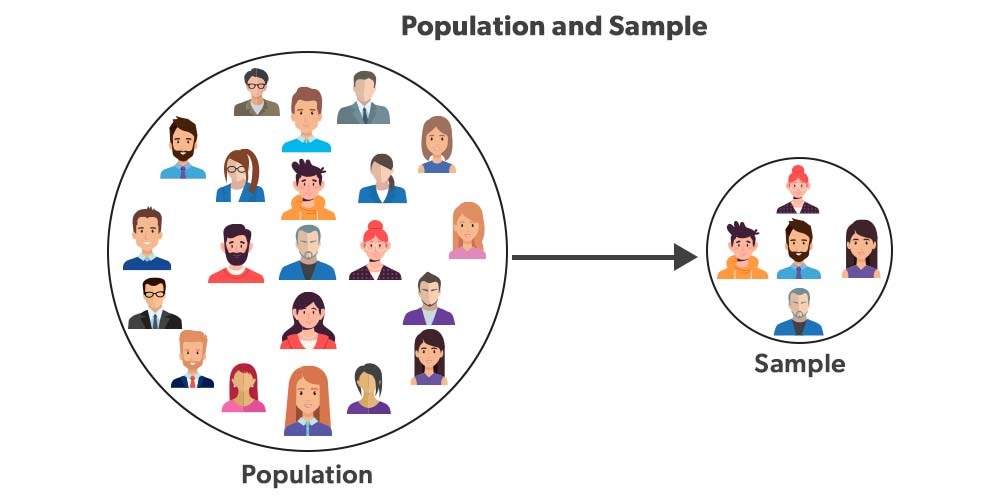Introduction to Statistics
Introduction to Statistics
Statistics is the science of collecting, analyzing, interpreting, presenting, and organizing data.
Descriptive Statistics: Summarize and interpret data to provide meaningful insights.
Inferential Statistics: Make predictions about a population based on sample data.

Why Do We Need Statistics?
- Data-Driven Decision Making: Provides a basis for informed decisions.
- Understanding Trends: Helps identify patterns and trends.
- Predict Future Events: Allows for forecasting.
- Scientific Research: Essential in hypothesis testing and experimentation.
Importance of Sampling
Efficiency: It’s often impractical to collect data from an entire population.
- Example: Surveying all 7,000 AUC students vs. a sample of 100 students.
Cost-Effectiveness: Sampling can be less expensive.
- Example: Reduced cost in time and resources for surveying a smaller sample.
Accuracy: Proper sampling techniques can yield highly accurate estimates.
- Example: A well-designed survey of 100 students can accurately reflect the opinions of all 7,000 students.
Population vs. Sample
Population: The entire group that is the subject of the study.
- Example: All 7,000 students at AUC
- Notation: \(N\) for size, \(\mu\) for mean, \(\sigma\) for standard deviation
Sample: A subset of the population used for making inferences about the population.
- Example: A survey of 100 AUC students
- Notation: \(n\) for size, \(\bar{x}\) for mean, \(s\) for standard deviation

Methods of Collecting Data
- Surveys: Questionnaires or interviews.
- Observations: Systematic observation and recording.
- Experiments: Controlled settings to observe effects.
- Archival Data: Existing records and databases.
Types of Variables
Quantitative Variables: Numeric data that can be measured.
- Continuous: Can take any value within a range (e.g., GPA).
- Discrete: Specific, countable values (e.g., Number of Courses).
Qualitative Variables: Descriptive, non-numeric data.
Nominal: Categories without order (e.g., Majors).
Ordinal: Categories with order but not equally spaced (e.g., Class Standing: Freshman, Sophomore, etc.).
Measures of Central Tendency 1/3
Mean: The average of all data points.
Population Mean: \(\mu = \frac{\sum_{i=1}^{N} x_i}{N}\)
- Example: Average GPA of all 7,000 AUC students is \(\mu = 3.5\)
Sample Mean: \(\bar{x} = \frac{\sum_{i=1}^{n} x_i}{n}\)
- Example: Average GPA of a sampled 100 AUC students is \(\bar{x} = 3.48\)
Measures of Central Tendency 2/3
Median: Middle value when data is sorted
Steps to find Median:
Sort the data in ascending order
- If \(n\) is odd, the median is the value at \(\frac{n+1} 2\)th position
- If \(n\) is even, the median is the average of values at \(\frac{n} 2\) and \(\frac{n} 2 + 1\) positions
Mode: The most frequently occurring value.
Measures of Central Tendency 3/3
When to use each measure
- Use the mean for normally distributed data
- Use the median when the data is skewed or has outliers
- Use the mode when dealing with categorical data

Measures of Dispersion 1/2
Range: Difference between the highest and lowest values.
Example: highest GPA: \(4.0\), lowest GPA: \(2.9\)
- Range: \(4.0−2.9=1.1\)
Variance: Average of the squared differences from the Mean.
- Population Variance: \(\sigma^2 = \frac{\sum_{i=1}^{N} (x_i - \mu)^2}{N}\)
- Sample Variance: \(s^2 = \frac{\sum_{i=1}^{n} (x_i - \bar{x})^2}{n-1}\)
Standard Deviation: Square root of the variance.
- Population Standard Deviation: \(\sigma = \sqrt{\sigma^2}\)
- Sample Standard Deviation: \(s = \sqrt{s^2}\)
Measures of Dispersion 2/2
When to use each measure
- The range is great for a quick overview, but it is sensitive to outliers.
- Variance and standard deviation are more robust and provide a clearer picture of the spread in your data.

Setting-up R & RStudio & Google Colab
